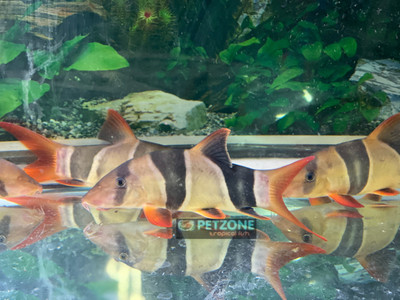Clown Loach (Chromobotia macracanthus)
Posted by Max Gandara on on 20th Nov 2024
Clown Loach: A Colorful and Playful Aquarium Favorite
Introduction
The Clown Loach (Chromobotia macracanthus) is a beloved freshwater fish among aquarists, celebrated for its vibrant orange and black bands, playful nature, and active schooling behavior. Originating from the rivers and floodplains of Southeast Asia, particularly in Indonesia’s islands of Sumatra and Borneo, the Clown Loach is a fascinating and social species that thrives in a well-maintained community aquarium.
In this blog, we’ll explore the Clown Loach’s natural habitat, care requirements, ideal tank mates, and tips for ensuring these captivating fish remain healthy and happy.
About the Clown Loach
- Scientific Name: Chromobotia macracanthus
- Common Names: Clown Loach, Tiger Loach
- Place of Origin: Native to Southeast Asia, particularly Sumatra and Borneo. Found in slow-moving rivers, streams, and floodplain waters rich in vegetation and submerged debris.
Clown Loaches are known for their striking appearance, featuring bright orange bodies with bold black vertical bands and red-tipped fins. As they grow, their vibrant coloration becomes even more pronounced, making them an eye-catching addition to any aquarium.
Natural Behavior and Social Needs
Clown Loaches are schooling fish that thrive in groups of at least 5 or more. In the wild, they live in large shoals, and replicating this environment in an aquarium helps them feel secure and exhibit their natural behaviors. They are playful and curious, often seen exploring their surroundings or interacting with tank mates.
Caring for Clown Loaches in the Aquarium
- Tank Size:
Clown Loaches can grow up to 12 inches in captivity, though most reach 8-10 inches. A spacious aquarium of at least 75 gallons is recommended for smaller groups, while larger groups or fully grown individuals require tanks of 125 gallons or more. - Water Parameters:
- Temperature: 77-86°F
- pH: 6.0-7.5
- Hardness: Soft to moderately hard water
Maintaining consistent water conditions is crucial, as Clown Loaches are sensitive to poor water quality. Regular water changes and efficient filtration are essential.
- Diet:
Clown Loaches are omnivorous and enjoy a varied diet. Offer high-quality sinking pellets, freeze-dried or frozen bloodworms, brine shrimp, and blanched vegetables like zucchini or spinach. Treats like snails can satisfy their natural predatory instincts and help control snail populations in the tank. - Tank Setup:
- Provide plenty of hiding spots with caves, driftwood, and dense plants.
- Use a sandy or smooth substrate to protect their delicate barbels.
- Dim or subdued lighting replicates their natural habitat and encourages natural behavior.
Good Tank Mates for Clown Loaches
Clown Loaches are peaceful and compatible with a variety of tank mates. However, their playful nature and size mean they should be housed with similarly sized or larger fish to prevent stress.
Recommended Tank Mates:
- Other Loaches (e.g., Yoyo Loach, Kuhli Loach)
- Tetras (e.g., Congo Tetra, Buenos Aires Tetra)
- Gouramis
- Rainbowfish
- Larger peaceful catfish (e.g., Plecos, Corydoras)
- Discus
Tank Mates to Avoid:
Avoid aggressive species or small, delicate fish that might become intimidated or accidentally injured by the loaches’ activity.
Fun Facts About Clown Loaches
- “Clicking” Sounds: Clown Loaches can produce audible clicking sounds when feeding or excited.
- Nocturnal Habits: They are more active during the evening and night but can adapt to daylight schedules in aquariums.
- Long Lifespan: With proper care, Clown Loaches can live for 15 years or more!
Conclusion
Clown Loaches (Chromobotia macracanthus) are a delightful addition to any aquarium, bringing vibrant colors, playful antics, and dynamic energy. By providing a spacious tank, compatible companions, and a well-maintained environment, you can enjoy the unique charm of these fascinating fish for years to come.
If you’re considering adding Clown Loaches to your aquarium, ensure you’re prepared to meet their social and environmental needs—they’re well worth the effort for the joy they bring to a tank.
Ready to Add Clown Loaches to Your Tank?
Explore our selection of healthy Clown Loaches and start creating a lively, colorful aquarium today!

